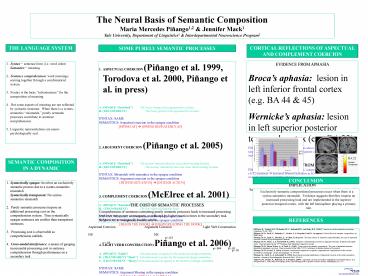48x36 poster template - PowerPoint PPT Presentation
1 / 1
Title: 48x36 poster template
1
The Neural Basis of Semantic Composition Maria
Mercedes Piñango1,2 Jennifer Mack1 Yale
University, Department of Linguistics1
Interdepartmental Neuroscience Program2
THE LANGUAGE SYSTEM
CORTICAL REFLECTIONS OF ASPECTUAL AND COMPLEMENT
COERCION
SOME PURELY SEMANTIC PROCESSES
EVIDENCE FROM APHASIA Brocas aphasia lesion
in left inferior frontal cortex (e.g. BA 44
45) Wernickes aphasia lesion in left superior
posterior temporal cortex (e.g. BA 22) Piñango
Zurif (2001) Brocas patients are above-chance
at interpreting both opaque (argument and
complement coercion) and transparent sentences.
Wernickes subjects are significantly impaired
for opaque sentences. EVIDENCE FROM
fMRI Piñango et al. (to appear) Normal
subjects comprehension of aspectual coercion
(ACE) sentences ? increased bilateral activation
in BA 22 but not BA 44, 45, or 47 with respect to
transparent (ACT) sentences. IMPLICATION Semanti
c processes depend on the integrity of the
superior posterior temporal cortex.
- ASPECTUAL COERCION (Piñango et al. 1999, Torodova
et al. 2000, Piñango et al. in press) - A. (OPAQUE Enriched) The boxer swung at his
opponent for an hour. - B. (TRANSPARENT) The boxer glared at his
opponent for an hour. - SYNTAX SAME
- SEMANTICS Aspectual coercion in the opaque
condition - SWING AT ? SWING REPEATEDLY AT
- 2. ARGUMENT COERCION (Piñango et al. 2005)
- A. (OPAQUE Enriched) The teacher intended
that her class finish reading Hamlet. - B. (TRANSPARENT) The teacher intended to have
her class finish reading Hamlet. - SYNTAX Mismatch with semantics in the opaque
condition - SEMANTICS Argument coercion in the opaque
condition - INTEND SITUATION ? INTEND ACTION
- 3. COMPLEMENT COERCION (McElree et al. 2001)
- 1. Syntax sentence form (i.e. word order)
- Semantics meaning
- 2. Sentence comprehension word meanings coming
together through a combinatorial system - 3. Syntax is the basic infrastructure for the
composition of meaning. - 4. But some aspects of meaning are not reflected
by syntactic structure. When there is a
syntax-semantics mismatch, purely semantic
processes contribute to sentence comprehension. - Linguistic representations are neuro-psychological
ly real.
BA 22 Opaque-Transparent
SEMANTIC COMPOSITION IN A DYNAMIC PERSPECTIVE
CONCLUSION
- 1. Syntactically opaque Involves an exclusively
semantic process due to a syntax-semantics
mismatch - Syntactically transparent No syntax-semantics
mismatch - 2. Purely semantic processes impose an
additional processing cost on the comprehension
system. Thus syntactically opaque sentences are
costlier than transparent sentences. - 3. Processing cost is observable as
comprehension unfolds. - 4. Cross-modal interference a means of gauging
incremental processing cost in sentence
comprehension through performance on a secondary
task.
Exclusively semantic compositional processes
occur when there is a syntax-semantics mismatch.
Evidence suggests that they impose an increased
processing load and are implemented in the
superior posterior temporal cortex, with the left
hemisphere playing a primary role.
THE COST OF SEMANTIC PROCESSES Comprehension of
sentences containing purely semantic processes
leads to increased processing load over
transparent counterparts, as reflected by higher
reaction times to the secondary task. Subjects
are neurologically healthy adults.
REFERENCES
Aspectual Coercion
Argument Coercion
Light Verb Construction
McElree, B., Traxler, M.J., Pickering, M.J.,
Jackendoff, R. and Seely, R.E. (2001). Coercion
in on-line semantic processing. Cognition, 78,
B17-B25. Piñango, M.M., Zurif, E., Palumbo, C.,
Gruber, S. Yurgelun-Todd, D. (to appear).
Cortical focus of semantic composition An fMRI
study. Piñango, M.M., Zurif, E., Winnick, A.,
Ullah, R. (in press). The time-course of
semantic compositionality the case of aspectual
coercion. Journal of Psycholinguistic
Research Piñango, M.M., Mack, J., Jackendoff,
R. (2006). Semantic combinatorial processes in
argument structure Evidence from light verbs.
Paper presented at the 32nd Meeting of the
Berkeley Linguistics Society. Piñango, M.M.,
Strom-Weber, A., Zurif, E. (2005).
Time-course of semantic composition The case of
argument structure alternation (argument
coercion). Paper presented at the 18th CUNY
Conference in Human Sentence Processing.
Piñango, M.M. Zurif, E. (2001). Semantic
combinatorial operations in aphasic
comprehension Implications for the cortical
localization of language. Brain and Language 79,
297-308 Piñango, M., Zurif, E., Jackendoff, R.
(1999). Real-time processing implications of
aspectual coercion at the syntax-semantics
interface. Journal of Psycholinguistic Research
28(4), 395-414. Todorova,M., Straub, K.,
Badecker, W. Frank R. (2000). Aspectual
coercion and online computation of sentential
aspect. In L. Gleitman and A. Joshi (eds)
Proceedings of the 22nd Meeting of the Cognitive
Science Society. Philadelphia, PA. 1-6.
NS
NS
p.03
p.03
p.01
p.03
p.004
p.03































